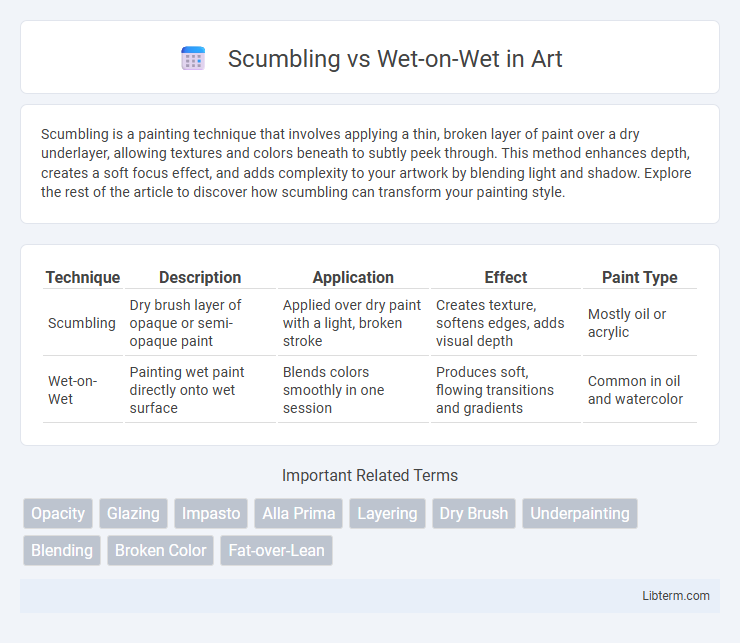Scumbling is a painting technique that involves applying a thin, broken layer of paint over a dry underlayer, allowing textures and colors beneath to subtly peek through. This method enhances depth, creates a soft focus effect, and adds complexity to your artwork by blending light and shadow. Explore the rest of the article to discover how scumbling can transform your painting style.
Table of Comparison
| Technique | Description | Application | Effect | Paint Type |
|---|---|---|---|---|
| Scumbling | Dry brush layer of opaque or semi-opaque paint | Applied over dry paint with a light, broken stroke | Creates texture, softens edges, adds visual depth | Mostly oil or acrylic |
| Wet-on-Wet | Painting wet paint directly onto wet surface | Blends colors smoothly in one session | Produces soft, flowing transitions and gradients | Common in oil and watercolor |
Introduction to Scumbling and Wet-on-Wet Techniques
Scumbling is a painting technique that involves applying a thin or broken layer of lighter, opaque paint over a darker underpainting to create texture and depth. Wet-on-wet, also known as alla prima, requires applying fresh paint onto still-wet layers, allowing colors to blend directly on the canvas for smooth transitions and vibrant effects. Both techniques are essential in oil and acrylic painting for achieving varied textures and dynamic visual interest.
Defining Scumbling: A Layering Approach
Scumbling is a painting technique that involves applying a thin, opaque layer of paint over a dry underpainting to create texture, depth, and subtle color shifts. Unlike wet-on-wet, where wet paint is blended directly on the canvas, scumbling uses a dry brush or lightly loaded brush to scrub or drag paint, allowing the underlying layers to show through. This method enhances atmospheric effects and soft transitions by building multiple semi-transparent layers, resulting in a rich, tactile surface.
Wet-on-Wet: The Art of Blending Colors
Wet-on-wet painting is a technique where wet paint is applied onto a still-wet layer, allowing colors to blend naturally on the canvas for smooth gradients and soft transitions. This method is favored in oil and watercolor painting to create atmospheric effects and seamless color integration. Unlike scumbling, which uses dry, broken strokes to create texture and layering, wet-on-wet emphasizes fluidity and the harmonious merging of hues.
Historical Origins and Influential Artists
Scumbling and wet-on-wet painting techniques trace their origins to the Renaissance, with scumbling emerging as a method to create texture using thin layers of opaque paint, prominently employed by artists like Rembrandt and Titian. Wet-on-wet, pioneered in the 15th-century Italian Renaissance and later popularized by Impressionists such as Claude Monet, involves applying layers of wet paint onto still-wet surfaces to achieve blending and soft transitions. Both techniques significantly influenced Western art, shaping methods in oil painting that emphasized texture and color dynamics.
Materials and Tools Needed for Each Technique
Scumbling requires stiff-bristle brushes, dry paint, and textured surfaces like canvas or rough paper to create a broken, airy effect, emphasizing layering of opaque or semi-opaque colors. Wet-on-wet demands soft brushes, fluid oil or acrylic paints, and a primed, smooth surface to allow seamless blending and smooth transitions of wet paint directly on the canvas. Palette knives or blending tools may also complement wet-on-wet for softer gradients, while scumbling leverages brush control to achieve its distinctive textured appearance.
Step-by-Step Guide to Scumbling
Scumbling involves applying a thin, semi-transparent layer of paint with a dry brush to create texture and depth, contrasting with the blending technique of Wet-on-Wet where wet paint is applied over wet layers for smooth transitions. To achieve effective scumbling, start by loading a dry brush with a small amount of paint, then lightly drag it across the surface in a scrubbing motion to build up texture gradually. Repeat this layering process, allowing each thin coat to partially reveal the underlying color, enhancing the visual complexity and richness of the artwork.
Step-by-Step Guide to Wet-on-Wet Painting
Wet-on-wet painting involves applying fresh paint onto a still-wet layer, enabling smooth blending and soft transitions that create atmospheric effects. Start by preparing a primed canvas, then apply a thin, even base layer of paint or medium to keep the surface wet. While the base is damp, quickly add subsequent colors, using gentle strokes or blending tools to merge hues seamlessly before drying occurs.
Comparing Effects: Texture, Depth, and Finish
Scumbling creates a textured, matte finish by applying a thin, opaque layer of paint that allows underlying colors to subtly show through, enhancing depth through surface irregularities. Wet-on-wet technique blends colors directly on the canvas, producing smooth transitions and a glossy finish that emphasizes fluidity and softness in forms. Both methods manipulate texture and depth uniquely: scumbling adds tactile variation and atmospheric richness, while wet-on-wet offers seamless color integration and luminosity.
Choosing the Right Technique for Your Artwork
Choosing between scumbling and wet-on-wet depends on the desired texture and blending effect in your artwork. Scumbling creates a rough, textured surface by layering dry, opaque paint over dried layers, ideal for adding depth and subtle highlights. Wet-on-wet allows smooth color transitions by applying wet paint onto wet layers, perfect for soft gradients and atmospheric effects.
Tips for Mastering Scumbling and Wet-on-Wet Methods
Mastering scumbling requires using a dry, stiff brush with light, circular motions to build textured layers without fully covering the underlying paint, enhancing depth and subtle color variations. For wet-on-wet technique, work quickly with ample medium to blend wet paint directly on the canvas, maintaining fluid transitions and soft edges essential for landscapes and portraits. Consistent practice with brush pressure control and paint consistency ensures precise execution of both methods, elevating overall painting dynamism and realism.
Scumbling Infographic

 libterm.com
libterm.com